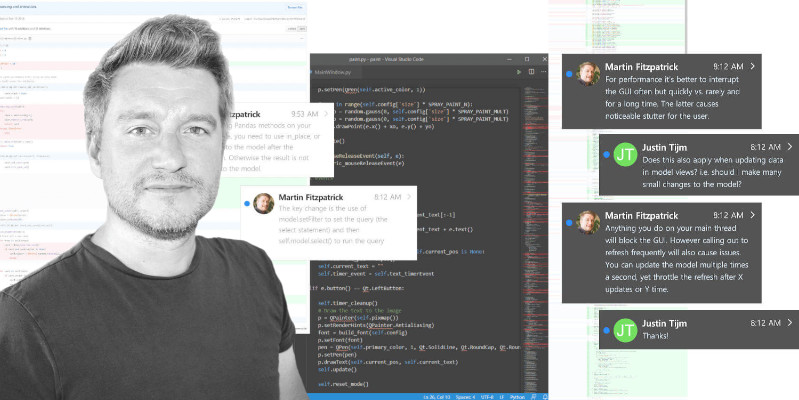As previously discussed, a central concept of open source licenses is that the author of a given program grants anyone permission to use, modify, or redistribute their code without seeking specific permission first. But these licenses generally cover the copyrights to the underlying code and not any trademarks that may be used by the original author in connection with their work.
A trademark is basically a word, phrase, symbol, or design--or any combination of those elements--that identifies a unique product or service in commerce. For example, "Python" is a registered trademark of the Python Software Foundation (PSF). The famous blue-and-yellow "intertwined snakes" Python logo is also a PSF trademark.
So how exactly do trademarks work? And as a developer, what can you do--and not do--with someone else's trademarks in your own work?
Trademarks Are Not Copyrights
To the layperson, it might seem like trademarks are just a method by which someone can copyright a particular word or phrase. In fact, copyright and trademark are distinct forms of intellectual property. A copyright applies to a created work, such as a book or a software program, that is original and exists in some fixed form. The purpose of copyright to is to enable the author to exercise exclusive control over the right to reproduce or distribute their work for a specified period of time.
A trademark, in contrast, is primarily about protecting consumers from harm. A trademark identifies the source of a good or service. This helps guard against potential counterfeiting or fraud while affording the trademark holder legal protection for their brand. But the trademark holder does not "own" the trademarked word or phrase. Rather, they exercise a limited right to use the trademark in connection with the sale of their product or service in a given area.
Trademarks can be used in connection with a variety of products within the same brand. The PSF uses its Python mark, for instance, not just to refer to the programming language itself but also merchandise such as T-shirts and hats. But the PSF could not enforce its Python mark in an area of commerce where it does not actually produce any products.
Like copyright, a trademark holder can register their mark with the government, although it is not required. In the United States, the U.S. Patent and Trademark Office (USPTO) manages trademark registrations at the federal level. A registered trademark is indicated by an "R" with a circle around it (®), while an unregistered trademark is indicated with the letters "TM" (™). As with copyright, registering a trademark provides certain legal benefits, such as a presumption that the mark is valid and belongs to the registrant.
Create GUI Applications with Python & Qt6 by Martin Fitzpatrick — (PySide6 Edition) The hands-on guide to making apps with Python — Over 10,000 copies sold!
When Do You Need a Software Trademark Holder's Approval to Use Their Name?
Another key difference between copyright and trademark is enforcement. With copyright, an author can be fairly lax in their assertion of rights without losing them. Indeed, open source licensing is essentially built around the notion that most developers do not want to spend their time policing how other people use their code. Yet the license itself still retains copyright in the event the author feels compelled to take legal action against infringement.
With a trademark, however, the holder needs to be more proactive in asserting their rights. The reason for this is that unlike copyright, a trademark can last indefinitely, provided it continues to be actively used and defended by the holder. The more passive the holder is in defending their rights, the more likely that the USPTO or a judge may find the trademark is no longer in active use.
For this reason, many organizations that rely on trademarks will publish a written policy governing their acceptable use. The PSF has a very detailed trademark usage policy, which provides a good model for how enforcement works in practice. Fortunately for developers, the PSF policy makes it clear that the organization wants the "Python" mark and logo "to be used with minimal restriction to refer to the Python programming language."
To be clear, even without this policy, there are many uses of the "Python" trademark allowed by U.S. law (and the laws of other nations) with respect to "fair use." There are basically two kinds of fair use: nominative and descriptive. Nominative fair use simply means you are referring to the trademarked good or service. So if you write a program in Python, you are allowed to refer to the "Python" trademark without asking the PSF's permission first.
Create GUI Applications with Python & Qt6 by Martin Fitzpatrick — (PyQt6 Edition) The hands-on guide to making apps with Python — Over 10,000 copies sold!
Descriptive fair use means you are using the trademark to describe some other product or service. This tends to come up when you are comparing one product with another. For instance, if you write an article comparing the benefits and drawbacks of Python with Rust, that would involve descriptive fair use. Again, you don't need permission to do this.
So when do you need a trademark holder's approval? The PSF's own policy states approval is necessary for any "commercial use" of the "Python" trademark to describe another product or company. In other words, you don't need the PSF's permission to describe your own program as being written in Python, or even to describe yourself as a Python developer. But you would need the PSF's permission to name your company something like "Python Software, Inc."
But what if you wanted to make or sell merchandise with the Python logo? Again, the PSF's policy permits anyone to use the logo without permission for non-commercial purposes. It's okay to make a Python-logo shirt for yourself and wear it at PyCon. But if you wanted to sell those shirts as PyCon, you would need a license from the PSF and potentially pay royalties on any sales.
Four Things to Know About Software and Trademarks
If you are developing software, you need to be aware of potential trademark issues. A qualified intellectual property attorney can answer specific questions for your situation. But speaking in general terms, here are four things to keep in mind:
- If you plan to use the name of any existing company or project in describing your own software, make sure to check and see if the trademark holders have a published policy regarding usage like the PSF.
- When selecting a name for your own project, you can check the U.S. Patent and Trademark Office's trademark database to see if the same or similar name is already in use with respect to software.
- Even if a trademark is not formally registered with the USPTO, that does not mean the trademark is not still legally protected.
- An open source license like the GPL, MIT, or BSD licenses do not convey any rights with respect to trademarks. Never assume that you can use the name of another software project in your own commercial application just because the underlying code is freely licensed.

